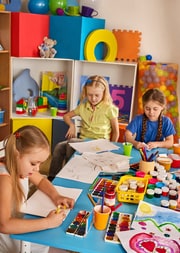9 Kindergarten Art Projects
It was a typical day in kindergarten. The sun shone in through the window, the children were laughing and talking as they worked on their art projects, and the teacher was droning on about something or other. But this wasn’t any ordinary kindergarten class. This was an experimental classroom where the children were taught how to be creative. And it was working!
The students in this class were always coming up with new and interesting art projects. They would use whatever materials they could find, including recycled materials, to create their masterpieces. And they loved doing it!
Your child will have a blast completing these 9 art projects, which are also educational! By the end of kindergarten, they’ll be sure to have developed many skills.
Here are 9 of the best kindergarten art projects that your child will love:
1. Marbleizing paste
Marbling is one of my favorite art projects for kindergarteners. You can do it every week!
Marbleizing is making pretty patterns from powdered paint. There are many different ways to do this project, so you can find something fun that works with your class’s learning style.
This activity requires very little instruction, which makes it great for beginners. This article gives an idea of how to set up the room for this activity.
You will need small bowls of water and calcium powder mixed in them to prepare the plaster. Then, you would put the ceramic tiles in the bowl and mix more water and calcium hydroxide until smooth.
After the mixture has dried overnight, you can use a chisel or cutter to carve the design into each tile. Lastly, wash the tiles and add a glaze if needed.
These painted marbleized tiles can be used in a variety of ways. You can use them to decorate walls or placemats. They can also make cool decorations for doorways or as clip-on bookends.
2. Sugar water experiment
Do you know what happens when you drop something really heavy into a glass of water? The object makes a little splash!
That’s because there are only around 1-2 pounds (about 0.45 kg) of pressure acting on that water surface. Pressing your finger onto the surface of a glass of water is how you feel the force pulling at your fingertip.
When you drop things in, it can make the water move more quickly, which creates bigger splashes. Or sometimes pieces break off the thing dropping so fast that the piece tears through the water.
How can we use this idea to help kids learn about shape? By having them drop different items into a cup of water!
Here are some ideas for this activity :
Have the children choose one or two shapes to try their hands at making. Then have them go back to the lab and explore another way to create a smaller splash with those shapes. This is an example of how kids learn science while creating art.
3. Mixing paint
This is an easy art project that can be done with children of different ages. You will need to purchase some supplies, so the total cost is relatively low.
This project involves the use of colors, shapes, and lines. It also requires no special materials or equipment. So what you are getting for your money is not just the price of the paint but the time you save by doing it at home instead of going to the store.
For young kids who love painting, this is a do-it-yourself kind of project. They will enjoy exploring new ways to mix colorings and see how different people have suggested different methods.
More advanced students may learn something from this too. By learning about why certain colors mix in specific ways, they can build on their knowledge when they move on to higher grades.
Furthermore, since this project uses two common types of paints, there’s a good chance they already have them around the house. No buying necessary!
4. Making sock cakes
This is an easy craft that you can do with your children to start the school year. And it’s also a project that can be completed in just one afternoon!
Sock cakes are an ancient Japanese art form, which consist of stacking layers of colorful socks and icing to create a cake.
This tradition began as a way for kids to learn how to count by moving objects around and emphasizing their role as food producers – like making choices about what they eat. Plus, it’s fun to make something unique and delicious using things that people don’t typically use.
5. Paste wrapping
This art project is perfect for beginners because there’s not too much preparation required. You will need paste, newspaper, and a mold to make the shape of your choice.
Once you have these materials, just put them together in this way. The children had a lot of fun playing with different types of shapes and sticking them onto the paper.
Some toddlers preferred placing the object first before applying the glue, others loved creating their designs. Either way, everyone enjoyed putting all the pieces together after it was dry.
6. Candles melting experiments
Do you know how candles are made? You can try your hand at making some of them using simple, accessible ingredients like wax, baking soda, and salt.
For this experiment, you’ll need to start with plain white candle wax. Look for wax online or in stores that sell craft supplies.
You can also purchase special-purpose waxes, such as tea light (sage) wax or colored wax pads for creating color effects. These wicks would be better choices if you were doing an educational activity with children.
This is an easy one! All you have to do is melt some water in a glass bowl. Then, sprinkle paraffin wax into the water gradually until everything melts evenly.
Once all the material is fused, put it upside down in the oven. It should pull away easily once it’s done. 🙂
There are several possible explanations for why solid objects might change shape when heated. The best explanation is that molten plastic releases internal stress and resumes its original form, which is what usually happens.
7. Letting rainfall on the canvas
This art project is very simple but also fun. You will need paint, water, paper, and some pots to put in the container.
Let the children choose which color they want their pot to be. Then, get two jars and fill one with water. Ask the child what colors of paints he/she would like to use.
Paint the jar with red paint and then add yellow paint to make it orange. Repeat this for as many colors as you feel comfortable.
Then, ask the child to grab an empty glass or mason jar and let them pour whatever color they want into it. They can mix all the colors or just leave each color alone separately in its jar.
When the kids are finished putting everything away, give them a box to place the smaller jars inside that will hold them while they decide what to do next. It helps keep track of how much stuff they have and sets a good example for recycling.
Once they’ve decided where they want these colors, bring out the bigger jars and have the children blend all the colors until you end up with only one color.
Ask the children why they made such a choice and wait for someone to explain it to them. Probably there was a reason they chose this color over the others!
8. Use newspaper to make soil
Start with some hard-boiled eggshells (for older children) or beans (2–4 years old). Add any desired herb including sea salt.
Then, melt some butter in a small bowl for younger children, or just add water for older children.
Mix all ingredients until you get a very smooth substance that resembles chocolate pudding. This is your soapy mud.
Next, let the kids decide what they want their garden to look like. Does it resemble wood? Or concrete? Give each child a square of paper and consider packing material, grass cuttings, dried fruit, flowers, etc.
Have them mix up whatever looks good to them. Don’t worry about perfection because parents will be picking up supplies after lesson two, anyway!
9. Bucket of paint to make art
For your students to understand that art is all around them, there are many opportunities during the school year to create artistic designs. One example is using buckets of watercolor or natural materials such as sand, dirt, cement, etc.
These supplies can be expensive, so check online for cheap deals.
Supplies you will need are a bucket, egg carton (or something similar), a clean glass jar, a label, a small stick/cherry, markers, and coloring books. It’s great if they are age-appropriate because kids have fun with stickers in colors that mean something special to them.
First, get some blank labels from the drugstore or office supply store. Some good ideas include name, address, phone number, or even email.
Put up one label per page after writing a line item below it explaining what the label means and who it belongs to. For instance; “ write me an essay of no more than 1 page describing our topic and illustrating how math is relevant to it.”
Next, put up posters asking people to help keep pens sharp and scissors nice and tidy by putting paper on both ends of the tray when doing their homework.
Let children know that these are very important tools that they should use whenever they work at home or go back to school. This way, they respect the effort others have made to get everything done nicely.
About the Author:
 Amy has a wealth of parenting experience, from when she was an expectant mother to now being the parent of both a teenager and a preschooler. Her blog AmyandRose is aimed at simplifying life for new parents as they navigate their way through parenthood while balancing other aspects of life.
Amy has a wealth of parenting experience, from when she was an expectant mother to now being the parent of both a teenager and a preschooler. Her blog AmyandRose is aimed at simplifying life for new parents as they navigate their way through parenthood while balancing other aspects of life.
Follow AmyandRose on Instagram | Facebook | Pinterest | YouTube | Twitter
Is your child ready for Kindergarten? Learn why preschool is good for your child.





